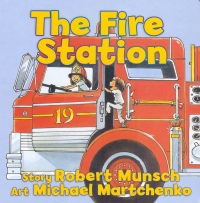| ________________
CM . . . . Volume XIX Number 11 . . . . November 16, 2012
If I were to say to you, “We all sat around the kitchen table,” I suspect that you would understand what I meant by the word “table” and that, if asked, you could conjure up a mental image of a table. Though “our” mental tables might differ in colour, size, materials, etc., they would all have the key ”ingredients” of a table, i.e. “An article of furniture supported by one or more vertical legs and having a flat horizontal surface.” (Free Online Dictionary). Now, if I asked you to saw an inch off the leg(s) of that table, would it be still a table? And, if I repeated that sawing request several times, at what point would you say that the object is no longer a table? That question, posed to me decades ago in an undergraduate philosophy class, reemerged in a new form when I compared the board book version of The Fire Station with the text of the 1991 version (the picture book was originally published in 1983).
In the board book, Michael still makes the same statement, but Sheila’s response is now:
In terms of Martchenko’s illustrations, the original first page illustration that showed the friends standing outside a fire hall has been deleted, and this freed-up space has now been utilized for the board book’s closing page that shows the two friends in the back seat of the police car as it speeds away. In summary, the board book version of The Fire Station is still a “table”, but it is not nearly as “ornate” as the original. Hopefully, when those toddlers who were read the board book later encounter the original version, they won’t adopt a “been there, done that” attitude and simply take a pass. Recommended. Dave Jenkinson, CM’s editor, lives in Winnipeg, MB.
To comment
on this title or this review, send mail to cm@umanitoba.ca.
Copyright © the Manitoba Library Association. Reproduction for personal
use is permitted only if this copyright notice is maintained. Any
other reproduction is prohibited without permission.
NEXT REVIEW |
TABLE OF CONTENTS FOR THIS ISSUE
- November 16, 2012.
AUTHORS |
TITLES |
MEDIA REVIEWS |
PROFILES |
BACK ISSUES |
SEARCH |
CMARCHIVE |
HOME |

 To fit the new smaller format and to respond to a younger audience, the text of the original story has been edited and truncated, and while the general overall shape of the story remains essentially the same, the board book version has lost all of the over-the-top detail one normally associates with Munsch’s storytelling. For those readers who know the original, the simplified telling will also alter their perceptions of the two main characters. In the original, as Sheila and Michael pass a fire house, Sheila boldly suggests, “‘Michael! Let’s go ride a fire truck.’” Michael’s cautious response is to suggest that he first check with his parents. That detail, along with Sheila’s bossy reaction, is now omitted. In the board book, Sheila asks the fireman, who has responded to her loud knocking, “Could you show us the fire station?’” In the original, Michael lists the numerous things he would like to see, and then Sheila concludes by asking the fireman, “‘And maybe...you will let us drive a fire truck?’” That fireman responded to her request with, “‘Certainly not.’” The present board book’s fireman is silent, and the two children simply and directly get into the back seat of a fire truck. When the fire hall receives an alarm notice, the pair of stowaways are accidentally taken to a fire where the smoke discolours their clothing and bodies. A fire chief drove the pair to their respective homes in the original, but the board book characters seemingly make their way home independently. Both “dirty” children, initially unrecognized by their parents, are again on the receiving ends of baths, but without the original’s details. The biggest plot change occurs at the conclusion of the story. Originally, the friends passed a police station, and the following conversation ensued.
To fit the new smaller format and to respond to a younger audience, the text of the original story has been edited and truncated, and while the general overall shape of the story remains essentially the same, the board book version has lost all of the over-the-top detail one normally associates with Munsch’s storytelling. For those readers who know the original, the simplified telling will also alter their perceptions of the two main characters. In the original, as Sheila and Michael pass a fire house, Sheila boldly suggests, “‘Michael! Let’s go ride a fire truck.’” Michael’s cautious response is to suggest that he first check with his parents. That detail, along with Sheila’s bossy reaction, is now omitted. In the board book, Sheila asks the fireman, who has responded to her loud knocking, “Could you show us the fire station?’” In the original, Michael lists the numerous things he would like to see, and then Sheila concludes by asking the fireman, “‘And maybe...you will let us drive a fire truck?’” That fireman responded to her request with, “‘Certainly not.’” The present board book’s fireman is silent, and the two children simply and directly get into the back seat of a fire truck. When the fire hall receives an alarm notice, the pair of stowaways are accidentally taken to a fire where the smoke discolours their clothing and bodies. A fire chief drove the pair to their respective homes in the original, but the board book characters seemingly make their way home independently. Both “dirty” children, initially unrecognized by their parents, are again on the receiving ends of baths, but without the original’s details. The biggest plot change occurs at the conclusion of the story. Originally, the friends passed a police station, and the following conversation ensued.